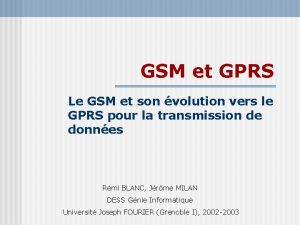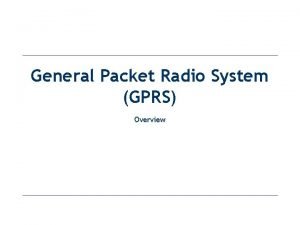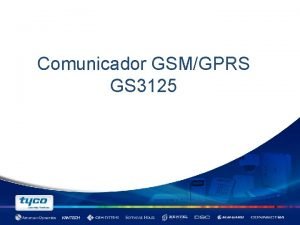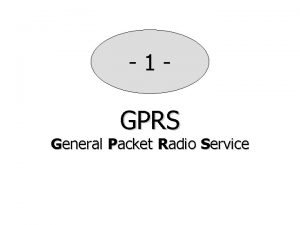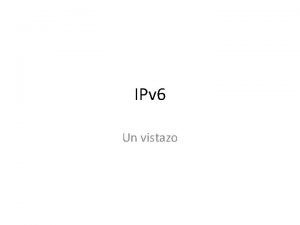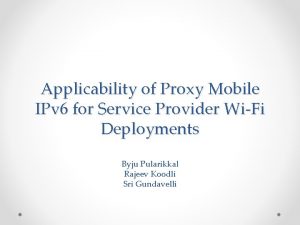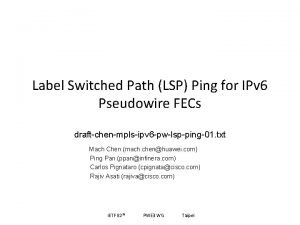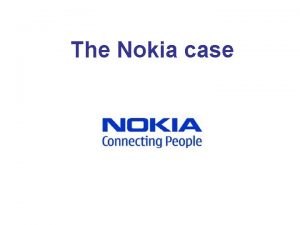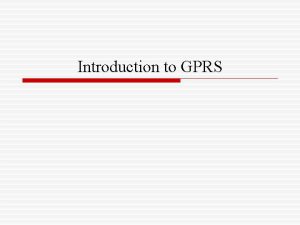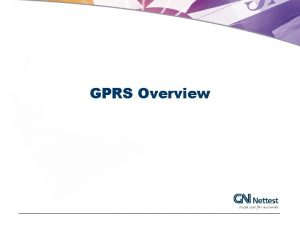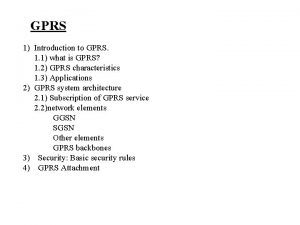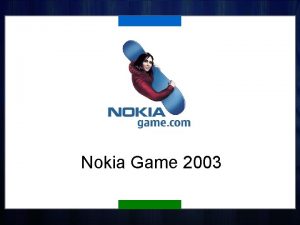GPRS Interworking with IPv 6 Preeti VinayakrayJani NOKIA


















- Slides: 18

GPRS Interworking with IPv 6 Preeti Vinayakray-Jani NOKIA RESEARCH CENTER HELSINKI, FINLAND © NOKIA IPv 6_forum. PPT / 04. 12. 2000 / Preeti Vinayakray page: 1

Outline • • • GPRS Architecture - Basic Services IPv 6 over GPRS - A Protocol Stack Interworking Mechanisms and their Examples GPRS Interworking with Internet Security Threats in GPRS systems with Examples Summary © NOKIA IPv 6_forum. PPT / 04. 12. 2000 / Preeti Vinayakray page: 2

GPRS Architecture Operator A Cellular world h SGSN VLR/HLR GPRS core Operator B GTP' BG (4&6) SGSN GPRS core GGSN Existing IPv 4 Internet © NOKIA VLR/HLR IPv 6_forum. PPT / 04. 12. 2000 / Preeti Vinayakray page: 3

Basic Services • Address acquisition • • stateless stateful assign single address assign subnet • • GGSN intercepts and replies to neighbor discovery messages possible design: GTP tunnel based on link-layer address only MN address assignment as a result of 'GPRS Activate Context' request (which is triggered during PPP setup) GGSN sends router advertisements once GTP tunnel is formed • Name resolution • • New DNS record types: AAAA and A 6 AAAA support already exists DNS server should be dual stack Data transfer © NOKIA IPv 6_forum. PPT / 04. 12. 2000 / Preeti Vinayakray page: 4

IPv 6 Over GPRS: Protocol stack © NOKIA IPv 6_forum. PPT / 04. 12. 2000 / Preeti Vinayakray page: 5

Visited Network Support • Network with IPv 6 support (v 6) • • Network with basic IPv 4 support (v 4) • • • no support for IPv 6 no enforcing for the use of a Mobile IPv 4 FA (may not support MIPv 4 at all) Network with IPv 4 supports in which use of external FA (Foreign Agent) is mandatory (v 4 FA) • • In such a network there is an IPv 6 router reachable by the mobile host - the router responds to IPv 6 router solicitation requests sent by the mobile host. The IPv 6 router has connectivity to the rest of IPv 6 world. An IPv 4 network not supporting IPv 6 and requiring the visiting mobile host to use an external FA in the network. In the first phase of evolution from IPv 4 to IPv 6, v 4 type of network will be the most common visited network type (v 4 FA networks most probably are rare because of the low deployment of MIPv 4). © NOKIA IPv 6_forum. PPT / 04. 12. 2000 / Preeti Vinayakray page: 6

Interworking Mechanisms • Encapsulation • • • Supports end-to-end IPv 6 connectivity over IPv 4 networks Configured tunnels (does not scale) Automatic encapsulation (requires 1 public IPv 4 address per recipient) 6 to 4 encapsulation (requires 1 public IPv 4 address per site) Protocol translation • • Necessary for communication between IPv 4 and IPv 6 end points Network layer translators SIIT, NAT-PT (require little or no host changes) • Upper layer translators SOCKS, ALGs • Temporary address allocation • Supports end-to-end IPv 4 connectivity between a dual stack mobile node and IPv 4 -only correspondent • • AIIH (assigning IPv 4 addresses to IPv 6 hosts) RSIP (realm specific IP) Conti………. © NOKIA IPv 6_forum. PPT / 04. 12. 2000 / Preeti Vinayakray page: 7

Conti. . . Temporary Address Allocation • AIIH may still be relevant • • Implementations reportedly under way Allows connections initiated from the outside - AIIH server is a combined DNS and DHCP server - Uses DHCPv 6 extensions (Reconfigure) • RSIP is promising but not a panacea • • © NOKIA Requires host modifications Intermediate node maintains state Potential problems with TCP states: refused connections, security exposures Some application may assume all <IP-address, port> pairs with the same 'IPaddress' end in the same node IPv 6_forum. PPT / 04. 12. 2000 / Preeti Vinayakray page: 8

Encapsulation Example: 6 to 4 • Requires only 1 IPv 4 address per site • Implemented on various OS • Appears to be popular and effective © NOKIA IPv 6_forum. PPT / 04. 12. 2000 / Preeti Vinayakray page: 9

Protocol Translation Example: SIIT • NAT-PT and BITS use translations specified by SIIT © NOKIA IPv 6_forum. PPT / 04. 12. 2000 / Preeti Vinayakray page: 10

Protocol Translation Example: SOCKS • host change required, but no changes to DNS, routing etc. • implementation is available • public acceptance unclear; but appears to be quite useful © NOKIA IPv 6_forum. PPT / 04. 12. 2000 / Preeti Vinayakray page: 11

Temporary address allocation example: RSIP client RSIP server Address space A Correspondent Address space B REGISTER_REQUEST ASSIGN_REQUEST (address in B, or address/port-range) data traffic via tunnel data traffic • preserves end-to-end functionality • seen as 'next best thing' to IPv 6 • no practical experience yet ASSIGN_REQUEST_EXT (address in B, or address/port-range) data traffic via tunnel data traffic DEALLOCATE DE-REGISTER REQUEST Note: Responses from RSIP server are not shown © NOKIA IPv 6_forum. PPT / 04. 12. 2000 / Preeti Vinayakray page: 12

Security Threats in GPRS systems • Denial of Service (DOS) • • • Malicious party gets to see all traffic directed to particular Mobile host Session Stealing/Spoofing • • • A particular victim Mobile host gets terminated Eavesdropping and floods the Mobile host with bogus traffic Intercepting packets destined to Mobile host Incompetent Translator • Attacker gains physical access via unattended network socket by exercising some ARP requests to DHCP and gets access to IP host and floods the network • • Simple attack through Intranet to GGSN's Gi interface © NOKIA Attack through GPRS Tunneling Protocol (GTP) IPv 6_forum. PPT / 04. 12. 2000 / Preeti Vinayakray page: 13

Security Threats : IP Attacks (1/3) © NOKIA IPv 6_forum. PPT / 04. 12. 2000 / Preeti Vinayakray page: 14

Security Threat : Attacks through GTP (2/3) © NOKIA IPv 6_forum. PPT / 04. 12. 2000 / Preeti Vinayakray page: 15

Security Threat : Through Translator (3/3) © NOKIA IPv 6_forum. PPT / 04. 12. 2000 / Preeti Vinayakray page: 16

GPRS Interworking with Internet • (1) Mobile node type and address • (2) GGSN AP type (IPv 4, IPv 6, 6 to 4, . . ) and address • (3) Possibly needed Tr. GW - needed functionality and address type • (4) Edge router (assumption: dual stack); functionality and address type • (5) Router 1 between IPv 4 Internet and IPv 6 network • (6) The host that the MN is connected to Operator own network "ADDR" MN IPv 6 Internet Tr. GW • NAT-PT (1) • RSIP • Encapsulaton / decapsulation SGSN GPRS GGSN • etc. Operator NW core IPv 4 intranet Operator IPv 4 services © NOKIA IPv 4 • ALGs (2) "ADDR" • If tunneling is needed, (6) what tunneling mechanism is used and Host IPv 6 what are the endpoints of stub NW the tunnel? Router 1 (3) (4) Edge Router FW IPv 6 intranet Operator IPv 6 services IPv 6_forum. PPT / 04. 12. 2000 / Preeti Vinayakray page: 17 Points to think about: Internet (5) • Is a translator such as NAT-PT needed in the case? • Is there a sufficient number of public IPv 4 addresses (most probably not) • . . .

Summary • • Suitable transition techniques for IPv 4 interoperability exist • use dual stack nodes, encapsulation, and temporary IPv 4 address allocation as primary interoperability mechanisms • • if protocol translation is necessary, use upper layer translators where possible use IP-layer protocol translators only when there is no other option Applicability of Transition Mechanisms • • • 6 to 4 encapsulating mechanism is more competitive than others • Security Consideration - Upgrade the existing IPv 4 servers with dual stack support In case of limited public IPv 4 addresses, currently the use of RSIP is more preferred choice - To preserve end-to-end integrity of data and when protocol translation is necessary one should use SOCKS or ALGs than SIIT and NAT-PT - Trust Management with other operators is an important issue © NOKIA IPv 6_forum. PPT / 04. 12. 2000 / Preeti Vinayakray page: 18
 Preeti ramaraj
Preeti ramaraj Preeti sandwich franchise
Preeti sandwich franchise Preeti matkins
Preeti matkins Introducing neeta anil said
Introducing neeta anil said Gprs stands for ? *
Gprs stands for ? * Gsm et gprs
Gsm et gprs Gprs stands for
Gprs stands for Gprs architecture
Gprs architecture Gprs overview
Gprs overview Gprs architecture
Gprs architecture Cdma
Cdma Descargar software gprs dsc 3125
Descargar software gprs dsc 3125 Gprs attach in progress
Gprs attach in progress Gprs
Gprs Kepanjangan dari gprs adalah.... *
Kepanjangan dari gprs adalah.... * Ipv
Ipv Ipv to psd
Ipv to psd Ipv refresher course
Ipv refresher course Ping ipv
Ping ipv





